Pre-IPO
Short version: “Pre-IPO” refers to shares of a company sold before that company
goes public (before its initial public offering). These can be primary shares (newly
issued by the company) or secondary shares (existing shareholders selling). PreIPO investing gives access to private-company growth (and risk) with the goal of profiting when the company lists on a public exchange.
Below I’ll explain how the pre-IPO process works from both the company side
and the investor side, plus key terms, timelines, benefits, and risks.
pre ipo Key terms you should know
Primary vs Secondary
Primary = company issues new shares;
Secondary
existing holder sells their shares.
Lock-up
Agreement preventing sale for a set period after IPO.
Accredited/Qualified investor
Regulatory status required to buy private offerings.
Cap table
Who owns what % of company; crucial for dilution and proceeds.
Liquidation preference
Rights that affect who gets paid first on exits
Convertible note / SAFE
Alternative instruments that convert to equity later
Bookbuilding
Process underwriters use to discover IPO demand and set price.
- Potential for high returns if company does well at IPO.
- Earlier valuations are often lower than IPO price.
- Possibility of preferential terms (board seats, protective provisions).
Risks and downsides
High risk / illiquidity — shares are often hard to sell until IPO or a
secondary event.
Valuation uncertainty — private valuations can be inflated; IPO may
price lower.
Regulatory & market risk — IPO market conditions may change (deal
can be delayed/cancelled).
Information asymmetry — private companies disclose less than
public ones
Read our latest blog
Eldeco Infrastructure files draft papers with Sebi for ₹1,000-cr
 Posted By Equity Unlisted
Posted By Equity Unlisted  10/04/2025
10/04/2025







